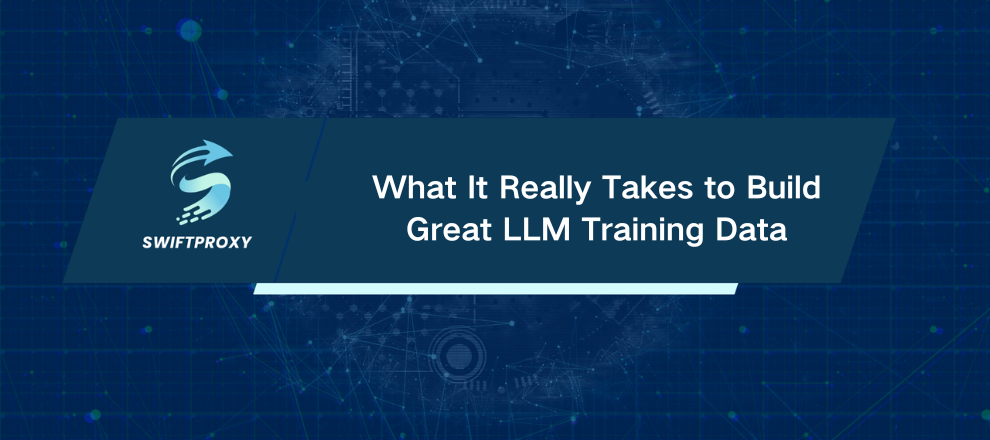What It Really Takes to Build Great LLM Training Data

Without data, AI is just a fancy calculator. It may sound blunt, but it captures the truth. Large Language Models like GPT, Claude, and LLaMA owe their remarkable abilities to one thing — massive, high-quality data. These models don't simply learn language; they absorb vast amounts of text to grasp context, nuance, and even intent.
But here's the kicker—where does all this data actually come from? How do AI teams gather billions—yes, billions—of words to train models that can write essays, code, and chat like a pro? If you work in AI, data science, or tech leadership, mastering the source and quality of training data is absolutely essential. It can make or break your model's accuracy, fairness, and relevance.
Let's pull back the curtain. We'll explore exactly what training data looks like, where it's sourced, and why cutting-edge proxy tech—like Swiftproxy's—has become a game-changer for AI teams. By the end, you'll know how to get the right data, fast, and ethically.
What Does LLM Training Really Mean
Training an LLM is like teaching a toddler to speak—but on steroids. Instead of a few thousand words, these models digest trillions of tokens. They start by learning broad language patterns—grammar, syntax, style—from massive general datasets. That's called pre-training.
Next, they get fine-tuned. This step sharpens the model for specific tasks or industries—legal jargon, medical terms, customer support dialogues—you name it.
Bottom line? The quality and diversity of your data dictate how smart and reliable your AI becomes. Skimp on data, and you risk bias, inaccuracies, and worse—outputs that confuse or offend.
What Kind of Data Feeds These Language Giants
LLMs don't feast on random text. They require a rich diet:
Books and Literature — Clean, polished language. Think classic novels and public domain treasures.
News and Articles — Current events, formal tone, journalistic precision.
Wikipedia and Encyclopedias — Neutral, fact-checked knowledge.
Forums and Q&A sites — Real human conversations, opinions, and problem-solving (Reddit, Stack Overflow).
Social Media — Slang, trends, informal chatter (filtered for quality).
Academic Papers — Specialized vocabularies for research-focused models.
Code Repositories — For coding AI, public GitHub projects provide real-world programming examples.
This mix ensures models can navigate everything from Shakespearean prose to tech troubleshooting.
How Do AI Teams Collect LLM Training Data
It's not like there's a giant "AI training dataset" store. Instead, the data is painstakingly gathered from multiple channels:
1. Web Scraping at Scale
Automated tools crawl public websites—news, blogs, forums, reviews—to pull text. But the web is a tricky place. Geo-blocks, IP bans, CAPTCHAs… the barriers are real.
2. Open Datasets
Projects like Common Crawl or The Pile give a great starting point, but they're often outdated or incomplete.
3. Licensed Content
Some companies pay for access to specialized or proprietary data. Expensive, yes, but sometimes necessary.
4. User-Generated Data
Customer support logs or human feedback can fine-tune models to perform better in specific domains.
The Hidden Challenge Behind Data Collection
Here's what makes gathering training data a high-stakes game:
Volume: Billions of tokens need fast, parallel scraping infrastructure.
Quality Control: Filtering duplicates, spam, and biased content is a must.
Geo and Content Restrictions: Without regional access, your model may miss cultural nuances.
Anti-Bot Defenses: Websites are smarter, blocking or throttling large-scale scraping attempts.
Legal Risks: Privacy, copyright, and compliance can't be ignored.
Why Proxies Are the Unsung Heroes of AI Data Collection
If you want to collect data at scale without getting blocked, proxies are your best friends. Here's how proxy network helps:
Geo-Flexibility: Access websites as if you're browsing from anywhere in the world. Train your models on truly global, multilingual data.
Stealth: Residential proxies look like real users. Unlike datacenter IPs, they fly under anti-bot radars.
Speed and Scale: Run thousands of simultaneous requests with smart IP rotation, avoiding rate limits.
Mobile Data Access: Tap into mobile-optimized sites and apps, unlocking fresh content.
Compliance and Control: Transparent dashboards and ethical usage policies keep your data acquisition safe and above board.
How Swiftproxy Empowers Smarter LLM Data Pipelines
Your LLM is only as good as its data pipeline. Swiftproxy delivers:
Global Proxy Network for pinpoint geo-targeting.
Multiple Proxy Types — residential, datacenter, mobile — for every scraping scenario.
Automated IP Rotation and 99.5% Uptime — keep your pipelines flowing nonstop.
Easy API Integration and Analytics — full control and insights at your fingertips.
Built-in Compliance — align with GDPR, CCPA, and ethical scraping standards.
This isn't just proxy service. It's your launchpad for powerful, accurate AI models.
The Bottom Line
Building competitive LLMs demands more than just GPUs and code. It demands smart, scalable, and ethical access to the richest, most diverse datasets on the planet. The web is vast. The barriers are real. But with the right proxy infrastructure, you break through restrictions and gather data that fuels real innovation.

















































